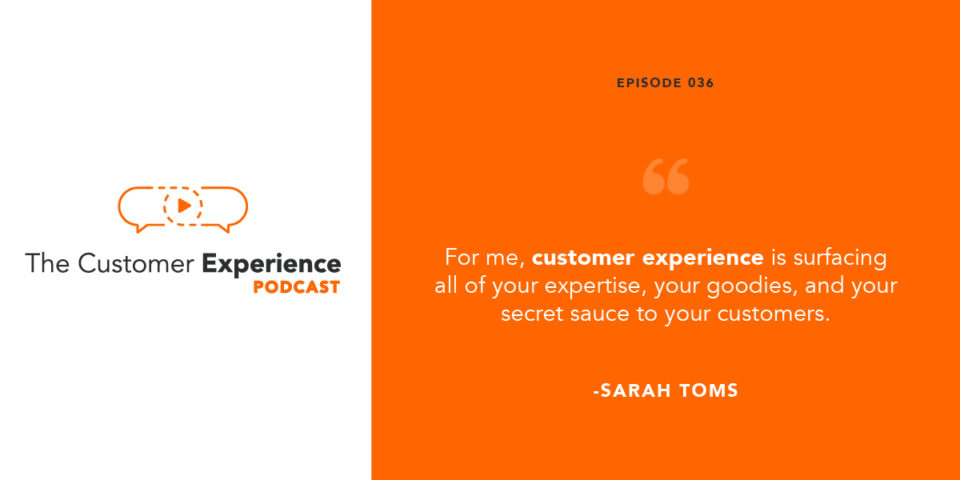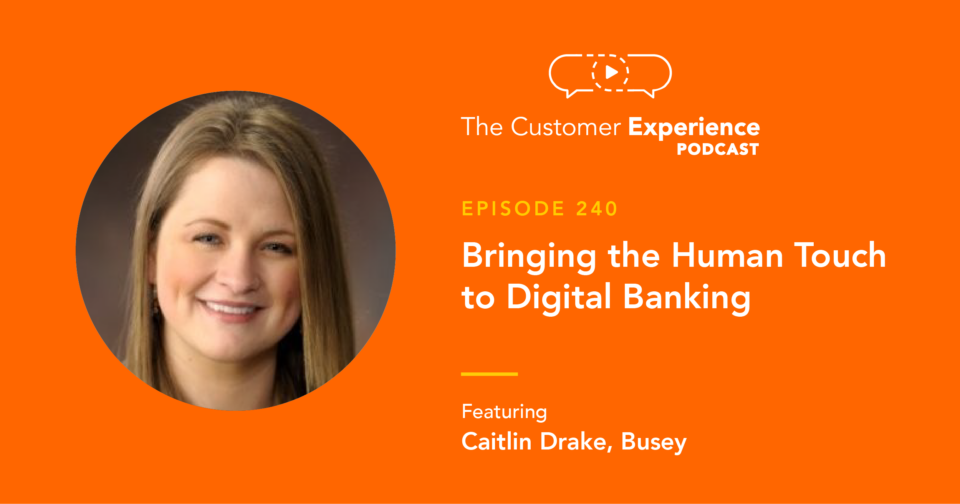
Apple Podcasts | Google Podcasts | Stitcher | Spotify
For any company – including yours – not all customers are created equal. Some are far more profitable than others. So it’s fundamentally important to know where, when, and in whom we should be investing.
A customer-centric culture sees every customer as valuable and works to put the customer first. But because your company has finite resources, you must identify those who provide a higher return on your investment of time and resources. In other words, you must consider the financial side of customer experience.
Creating a systematic approach to identify and invest in these customers is the focus this episode of The Customer Experience Podcast. To help us think through CX in a financial context, we’re honored to be joined by Sarah Toms.
Sarah has worked in the technology field for more than 25 years. For the past six of those years, Sarah has served in several IT director roles at The Wharton School at the University of Pennsylvania. She cofounded and currently serves as the Executive Director of Wharton Interactive. Along with her colleague Peter Fader, Sarah recently coauthored The Customer Centricity Playbook: Implementing a Winning Strategy Driven by Customer Lifetime Value, an Amazon bestseller in the Customer Relations category. (Fun fact: that Amazon achievement is something we have in common!)

For Sarah, customer experience is what the customer gets to touch and interact with. Creating the layers of your brand experience is similar to what an artist does in an oil painting. Much like departments of a company, all of the layers compile into a singular, aesthetic experience for each customer. She explains more in the clip below …
The Customer Centricity philosophy isn’t specific to providing great customer experience, nor does it focus solely on the customer-facing aspects of your business. But putting it into practice will facilitate and improve both.
Join us to hear Sarah walk through topics like:
- What Customer Centricity is at its core (and what it isn’t!)
- How to find your customers’ lifetime value (CLV or LTV)
- Why demographics and personas are antiquated and flawed
- How a customer-centric company like Starbucks transitioned to Customer Centricity
- How to apply The Customer Centricity Playbook within your own company
- Why the share of women in tech is dropping (and what to do about it)
- Much more!
The Financial Side of CX
Subscribe to The Customer Experience Podcast in Apple Podcasts so you can hear this episode and others like it anywhere and at any time.
Not an Apple listener? No problem! Access the podcast in Spotify, Google Podcasts, or Stitcher.
I also embed each episode of The Customer Experience Podcast in its companion blog post. So, you can listen to my entire conversation with Sarah Toms directly below …
What Customer Centricity Is and Why It Matters
Customer Centricity involves organizing your business functions around your customers, but Sarah and her co-author Peter Fader want us to know it’s not that simple. Quoting Peter directly, he defines Customer Centricity as:
“A strategy that aligns the development and delivery of a company’s products and services with the current and future needs of its highest value customers in order to maximize these customers’ long term financial value to the firm.”
Sarah Discusses what the elements of this model look like in the video clip below. They include, but are not limited to:
- Shifting your attention from the rear view mirror to the front windshield
- Leveraging past data about our customers
- Drawing ideas about how customers and future customers are going to perform
- Aligning tactics, strategies, and goals to invest appropriately into customer cohorts
Identifying, illuminating, and investing in these high-value customers can maximize your company’s returns. But Sarah is quick to point out that her co-author, Peter, acknowledges it’s not just about the high-value customers; we must factor in our mid- and low-value customers, as well. Being able to understand the role each customer plays in your company’s future revenue is crucial to applying The Customer Centricity Playbook.
Important, then, is the idea of customer heterogeneity. We need to recognize and celebrate the differences between our customers.
See how Sarah breaks this down in the next clip …
Customer Centricity is looks to shift the focus toward predicting customer cohorts’ needs, wants, and behaviors, sw we can invest accordingly and forecast returns more accurately. It doesn’t look strictly at customer experience or customer service, but rather advocates for data-driven strategies to more profitably drive those functions.
So, it’s easy to hear or read the words “customer centricity” and think “putting the customer first,” “customer centric,” or “customer oriented.” One of the clearest divides between these two approaches is made clear in the video clip below, in which Sarah talks about a customer-first brand, Starbucks, before and after proper Customer Centricity.
Take a look …
Ways To Understand Your CLV or LTV
For Customer Centricity to be effective, you need to understand the CLV (Customer Lifetime Value) or LTV (Lifetime Value) of your various customers. You might use CLTV (Customer Lifetime Value) or LCV (Lifetime Customer Value). As these terms are synonymous, we’ll use CLV.
What this model does is predict how much a customer will spend with your company throughout their relationship with you. This is based on the three RFM elements: Recency, Frequency, and Monetary Value.
If you run a coffee shop, a customer’s LTV will be based on how often she or he visits your shop, how much they spend on an average order, and how many times they’re likely to visit your shop over time. This can be more difficult to predict than recurring revenue in subscription-based models, in which an account renews at the same value every year or month, for example.
Sarah mentions that data in a non-subscription-based situation can be harder to obtain, but there will always be measures your business can use to forecast and predict.

Demographics and Personas As Antiquted and Flawed
Throughout her career and even today, Sarah has used personas while building software and apps, as many of our listeners do. But she also recognizes that personas and demographics are anqtiquated and flawed, especially as you execute from The Customer Centricity Playbook.
Why? Because each is a “blunt instrument” that doesn’t fully respect customer heterogeneity. Sarah explains these ideas and describes a “fun chapter to write” in the next clip …
The primary problem: we have a lot of customer data and it shifts and changes quickly, but our personas don’t shift with those data. Static personas are difficult to justify in our forecasting models.
Also, we have unconscious bias; humans tend to fill in information gaps with assumptions.
Rather than strictly using personas or demographics to capture and describe our customers, Sarah recommends taking them as guiding points and then focusing on each type of customer to identify their value to your company.
Getting Started with Customer Centricity
So now that we’ve discussed ways to slice and understand your company’s customer base and data, how do you apply the Customer Centricity framework?
This is one of Sarah’s favorite questions to answer. She shares some ideas and examples of successful adoption in the video clip below …
Adopting this model may seem difficult as you think about it in the context of your own business. Sarah sympathizes with companies figuring where to start with Customer Centricity and she offers three great tips to get started.
#1: You have to have data.
Whether your company has been around the block or you’re just starting out, Sarah wants to make it clear you need data. Testing hypotheses requires data from previous months to apply to future models.
If you have access to an analytics team, just check in with them and let the team know what you’re trying to do. If you’re a small business, do gather what data you can, even if it’s on a spreadsheet. Taking the time to obtain this data so you can get started on your company’s investments for the future is worth the challenge.
#2: You have to start small.
Sarah begins with an example of video game company Electronic Arts, and the broad budget spend they had on marketing for 20%. No one was checking to see if this method returned any value, causing a few junior data analysts to investigate. Taking a portion of the marketing budget, they looked at the raw data to see how the investment was paying off.
This grew into their full application of the Customer Centricity model EA uses today. So, identify a small experiment that’s feasible to get metrics on and start there.
#3: You have to stop talking about “the customer.”
This is another go at customer heterogeneity. For Sarah and Peter, “the” and “customer” are dirty words when they’re put together. There is no such thing as “the customer.”
Sarah addresses this again in the next clip …
Going away from finding “the customer” to laser focusing on specific customer segments and what their LTV will be for your business is what Customer Centricity is all about. Sarah acknowledges this requires a potentially challenging shift in focus, but the rewards far exceed the costs if your company can dedicate themselves to this framework.
The Marketing Problem of Women in Tech
Sarah is involved with The Women in Tech Summit, an organization and event helping women enter the ever-growing technology industry. Because it’s something we’re actively thinking about and working on here at BombBomb, I didn’t want to let Sarah go without asking about her own experiences and insights.
Check out this final video clip for her thoughts on the current state of women in the tech industry …
Statistically, the share of women in tech is dropping every year, hovering at 22-23% currently. The primary contributing factor: the number of new tech jobs being created far outpaces the number of young women being prepared and attracted to fill them.
Instead of glass ceilings, Sarah sees the issue as more like glass walls. We’ve cultivated the idea of the “brogrammer” as the cultural standard of working in tech. It’s why it seems so unappealing to young women, even though the reality is far from this picture. The tech space is highly attractive and highly creative. It allows the ability to change paths and dynamically apply skills built over a career to a broader spectrum of roles and opportunities. In addition, the tech space is continuously evolving to support a better work-life balance.
Marketing to young women at the middle school age and throughout their K-12 experience is what’s needed to engage more of them in the tech industry. Female role models thriving and succeeding in the space is what we need to show to them as they enter college, so they’re more interested in pursuing these careers.
Our companies will all be better for it.
This post is based on conversation with Sarah Toms, cofounder and Executive Director of Wharton Interactive and coauthor of The Customer Centricity Playbook: Implementing a Winning Strategy Driven by Customer Lifetime Value.
If you’re interested in learning more and taking the next step yourself, sign The Customer Centricty Manifesto. Its tenants:
- Customer Heterogeneity over the average customer
- Cross-Functional Uses of CLV over siloed applications
- Metrics That Reflect Customer Equity over volume and cost obsession
- Clear Communications with External Stakeholders over misalignment and misunderstanding
Thanks, congratulations, and continued success to Sarah and her coauthor Peter Fader on advancing the Customer Centricity perspective and practice!
Join The Customer Experience Conversation!
Follow the evolving customer experience conversation. Subscribe to The Customer Experience Podcast in Apple Podcasts.
While you’re there, please leave a rating or review to help other people find and enjoy the podcast!
If you don’t use Apple Podcasts, check out the show on:
What will you get when you subscribe?
Available Episodes Like …
- “Balancing Automation, Artificial Intelligence, and Human Relationships” with Samantha Stone (founder and CMO, The Marketing Advisory Network)
- “Why Friction Is a Customer Experience Killer” with Brian Gilman (VP of Product Marketing, Vonage)
- “‘The Holy Grail’ of Connecting with Your Customers” with Ann Handley (Chief Content Officer, Marketing Profs)
- Click right here to see more!
Future Episodes With …
- Sangram Vajre – cofounder and Chief Evangelist at Terminus and coauthor of ABM is B2B
- Dan Tyre – sales executive at HubSpot and coauthor of Inbound Organization
- Lance Risser and Levi Ayriss – VPs of Field Operations for Dutch Bros Coffee
Building Lifetime Value by Getting More Personal and Human Again
As Sarah and her coauthor Peter advise, a data-driven approach helps drive better experiences for your customers and better outcomes for your business.
Great relationships with your customer and future customers underpin your success and can manifest as higher CLVs.
One way to immediately improve those relationships? Being more personal and human in more of your day-to-day communication.
Rehumanize Your Business gives you specific frameworks, success stories, and practical tips to help you and your team put video to use in a meaningful way.
Like The Customer Centricity Playbook, this book is a #1 Amazon bestseller in Customer Relations.





